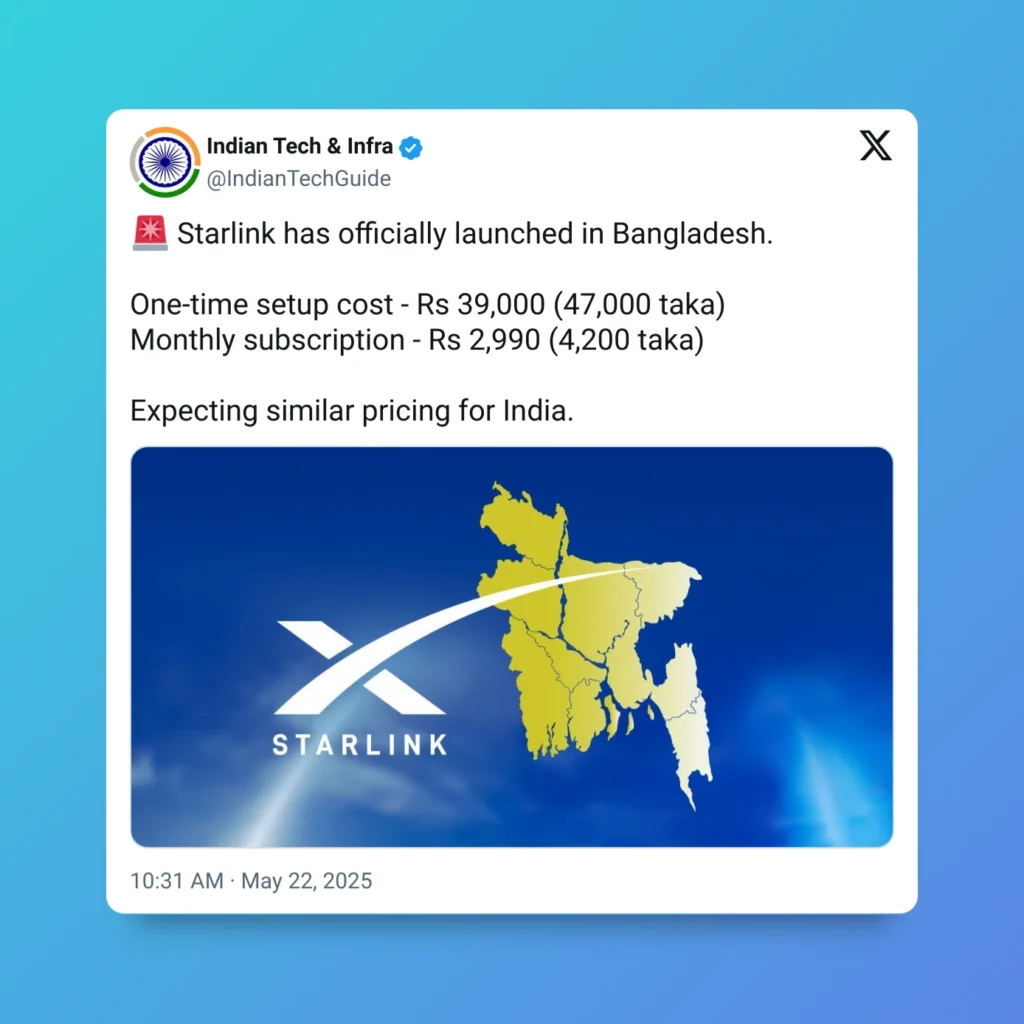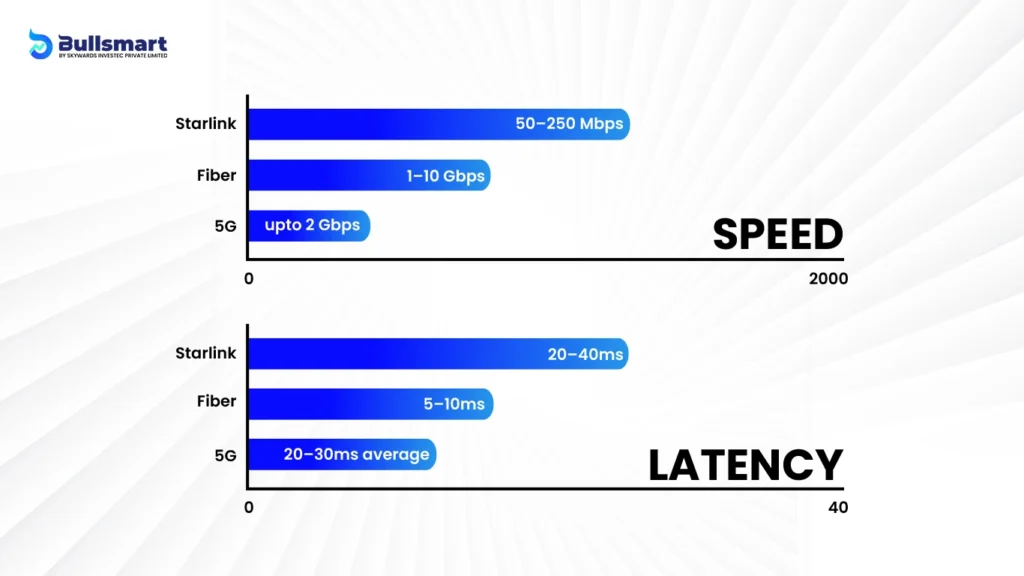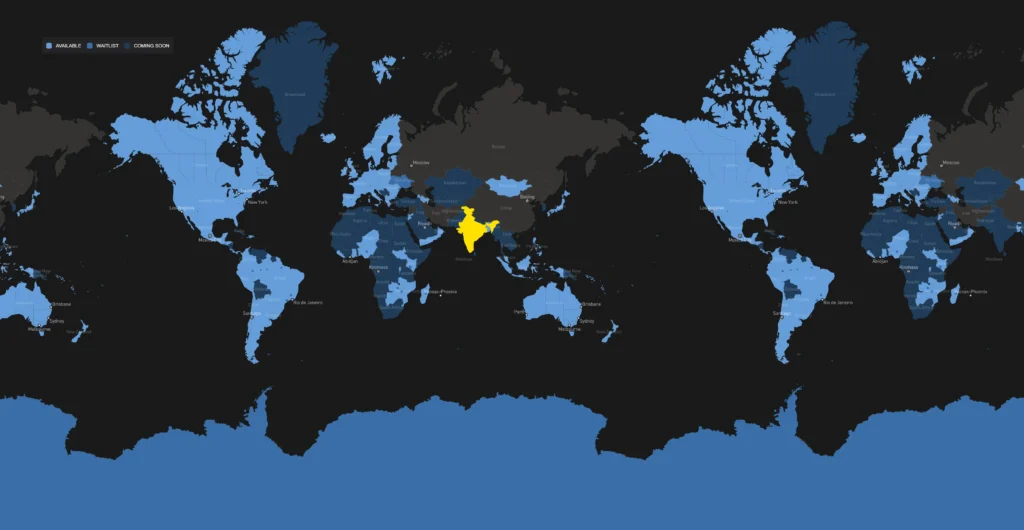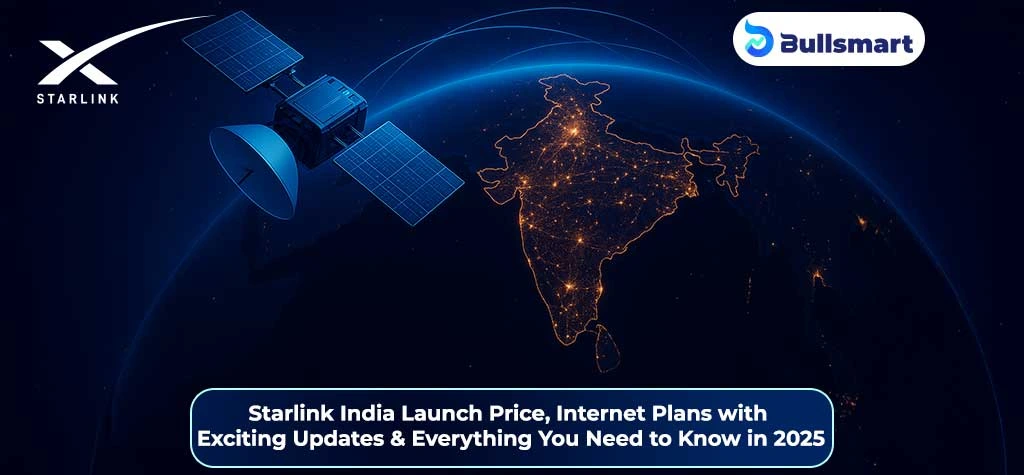Starlink in India is all set to launch! The satellite internet game-changer backed by Elon Musk’s SpaceX is finally gearing up to land, and it’s not just hype.
With 5,000+ satellites already cruising in low Earth orbit, Starlink’s mission is crystal clear: high-speed, low-latency internet for everyone, no matter where you live on the map.
And for a country like India, where millions still struggle to get solid broadband, especially in remote and rural zones; this could be huge.
While regular telecoms battle terrain and infrastructure costs, Starlink just beams right past it all. Think of it as a digital leapfrog that might finally shrink India’s urban-rural internet gap.
This blog spills all the tea on what’s coming: from the official India launch date and Starlink share price updates, to monthly internet costs and how it stacks up against your regular broadband.
If you’re a remote worker, small-town entrepreneur, or just a tech geek watching the skies, this is the deep dive you don’t want to miss.
Starlink’s India Launch Timeline: 2025
The road to launching in India has been anything but easy. It first tried to enter the market in 2021 but ran into serious regulatory roadblocks.
The Department of Telecommunications (DoT) asked Star-link to stop taking pre-orders due to missing licenses. What followed was a long back-and-forth, as India tightened its satcom rules; especially around security and data privacy.
But 2025 is shaping up to be a turning point. In May, SpaceX finally got a Letter of Intent (LoI) from the DoT, which marks a big step that opens the door to:
- Applying for spectrum allocation
- Securing operational licenses from IN-SPACe (India’s top space commerce regulator)
What’s the expected launch timeline?
According to The Economic Times and TechCrunch:
- Launch window: Late 2025 to early 2026
- Priority areas: Remote and rural zones where traditional broadband doesn’t reach
Local Partnerships in India
This is where things get interesting. As per reports from AP News and India Today:
- Star-link is in talks with Reliance Jio and Bharti Airtel
- These partnerships could:
- Use existing telecom infrastructure
- Speed up rollout timelines
- Potentially reduce costs for Indian users
- Use existing telecom infrastructure
This collaborative approach also fits in perfectly with the Digital India mission, bringing reliable, high-speed internet to every corner of the country.
Starlink India Internet Pricing & Plans: What to Expect
Star-link is entering India with a super competitive pricing strategy, and it’s already making waves.
According to The Economic Times and Gadgets 360, the basic unlimited data plan is expected to be priced under ₹850/month (roughly $10). That’s a huge drop from its U.S. pricing, which starts at $120/month.
The goal? Make satellite internet affordable and accessible; especially in regions where traditional broadband still hasn’t reached.
Star-link is reportedly aiming for 10 million subscribers in India within the next 5 years. The Star-link price and plans can differ slightly upon their disclosure in the Indian subdomain.
But while the monthly plans are budget-friendly, the one-time hardware cost might make some users think twice.
Here’s a quick breakdown of supposed star-link India price per month model:
Starlink India Pricing
| Category | Details |
| Monthly Plan (Unlimited) | Under ₹850/month (~$10) – significantly lower than U.S. pricing |
| Hardware Kit | ₹21,300 – ₹32,400 (includes satellite dish, Wi-Fi router, tripod) |
| U.S. Hardware Cost | ₹49,900 + ($599) |
| Subscriber Goal | 10 million users over 5 years |
| Subsidy/EMI Options | Likely partnerships for government subsidies and financing schemes |
| Launch Offers | Possible discounts and free installation during initial rollout |
| Investor Buzz | Rising interest in Starlink share price in India and SpaceX-backed growth |
Data available is as of 27.05.25.

Image Source: Twitter
Starlink India Speed
Check this comparison table showing Starlink India speed vs. other popular internet technologies in India:
| Technology | Download Speed | Upload Speed | Latency | Ideal For | Availability |
| Star-link India | 50 – 250 Mbps | 10 – 40 Mbps | 20 – 40 ms | Streaming, video calls, online learning, rural use | Expected late 2025–2026 |
| Jio Fiber | 30 Mbps – 1 Gbps | Up to 100 Mbps | 5 – 15 ms | UHD streaming, gaming, work from home | Urban & semi-urban areas |
| Airtel Xstream | 100 Mbps – 1 Gbps | Up to 100 Mbps | 5 – 20 ms | Streaming, enterprise use, gaming | Widely available in cities |
| 5G (Airtel/Jio) | 100 Mbps – 2 Gbps (peak) | 10 – 100 Mbps | 20 – 30 ms | Mobile usage, hotspot connectivity | Urban & Tier-1/2 cities |
| DSL Broadband | 10 Mbps – 50 Mbps | 2 – 10 Mbps | 40 – 80 ms | Basic browsing, emails | Rural & older urban areas |
| 4G LTE | 5 – 50 Mbps | 1 – 10 Mbps | 30 – 80 ms | Mobile internet, remote access | Nationwide |
Data available is as of 27.05.25.

Suggested Read: Why AI and 5G Will Skyrocket Your Smart Investments by 2025
What This Means for India
Starlink’s blend of low-cost monthly service and optional hardware financing could be a game-changer for underserved and remote regions. With talks of local assembly and government support, there’s potential for further cost cuts down the road.
And for investors? The buzz around Starlink share price is only growing; thanks to India’s huge market potential and SpaceX’s global reputation.
Starlink Internet Speeds, Coverage & Performance
Star-link is stepping into India with some serious tech power. Unlike traditional satellite internet, which often struggles with delays and poor streaming quality, Starlink’s low Earth orbit (LEO) constellation is built for speed and low latency. This makes it ideal for real-time activities like gaming, online learning, and video calls.
The initial rollout will focus on regions that need it most—rural and remote parts of India. Over time, Star-link plans to expand its footprint to semi-urban and urban areas as spectrum access and satellite capacity grow.
Performance in countries like the U.S., Canada, and Australia has been mostly positive, especially in areas where regular broadband falls short.
Early adopters have managed to stream Netflix, attend Zoom classes, and even game online with minimal disruptions.
And thanks to upgraded hardware, newer Star-link kits are proving to be more resilient in extreme weather, which is something that could be a huge plus in monsoon-affected areas of India.
Starlink India Performance Snapshot
| Feature | Details |
| Download Speed | 50 – 150 Mbps |
| Latency | 20 – 40 ms |
| Initial Coverage | Rural and remote regions |
| Expansion Plans | Semi-urban and urban areas in later phases |
| Optimized For | Video calls, streaming, gaming, e-learning |
| Global User Reviews | Positive in remote zones of U.S., Canada, Australia |
| Hardware Reliability | Improved performance in bad weather & outages |
Data available is as of 27.05.25.
If India’s real-world experience matches the global benchmarks, Starlink could become a total game-changer for users living beyond the reach of fiber and mobile broadband.
Starlink’s Competitors in India
Starlink might be stealing the spotlight, but it’s not the only one gunning for India’s satellite internet space. The broadband-from-space race is heating up, and some big names are on the launchpad.
- Eutelsat OneWeb, backed by Bharti, already has 600+ LEO satellites up and running. It’s going after enterprise clients and remote gov projects—with a major head start on the policy front.
- Jio-SES (Reliance + SES) is cooking up high-speed satellite internet using O3b mPOWER. Their goal? Powering rural zones and boosting mobile networks.
- Globalstar, a U.S. satellite firm, is eyeing India too; but with a niche game plan: think oil rigs, cargo ships, and remote sensors.
Here’s a quick table comparing the major satellite internet players in India:
| Provider | Target Market | Deployment Status | Local Partners | Coverage Focus | Consumer Accessibility |
| Starlink | Households, SMEs, rural users | Global: 5,000+ satellites; India launch 2025–26 | Possible partnerships with Jio/Airtel | Pan-India, starting rural | High – direct-to-consumer, easy DIY setup |
| Eutelsat OneWeb | Enterprises, government, remote areas | 600+ satellites deployed | Bharti Group backing | Enterprise & rural | Medium – mostly B2B focus |
| Jio-SES | Rural connectivity, mobile backhaul | Pre-launch; O3b mPOWER tech | Reliance Jio (JV) | Rural and mobile networks | Medium – infrastructure focus |
| Globalstar | Industrial sectors (oil, maritime) | Exploring Indian market | None publicly known | Niche industrial zones | Low – no consumer focus |
Data available is as of 27.05.25.
Starlink’s Impact on Connectivity: Rural & Remote
Here’s why Starlink could be a total game-changer for rural India’s internet:
- Over 60% of rural homes still lack reliable internet, and Starlink’s satellite tech needs only clear skies and power, no cables or towers.
- It’s already proven in tough spots like Peru and Canada, showing it can bring stable internet to off-grid areas.
- Starlink fits perfectly with India’s Digital India mission, filling gaps where fiber can’t reach, especially in remote and disaster-prone zones.
- With better internet, rural communities can access education, healthcare, digital payments, and real-time farming info like weather and crop data.
- If supported by the government, Starlink could help rural India leap into the digital future fast.
Regulatory Landscape & Licensing
Here’s the gist of Starlink’s legal journey in India:
- Starlink needs a commercial license from IN-SPACe and spectrum approval from the DoT’s Wireless Planning & Coordination wing.
- India’s 2025 satellite rules include 30+ security measures like data localization and using the homegrown NavIC system.
- These rules aim to protect India’s security while allowing foreign satellite services.
- The big question: Will spectrum be auctioned or directly allocated? This impacts how fast and cheap Starlink can launch.
- If all approvals happen smoothly, Starlink could be among the first global satellite internet providers officially launching under India’s new rules.
- This would also pave the way for other foreign satellite companies.
Challenges & Concerns
Here’s the deal: Starlink has big potential in India but faces some hurdles.
- Cost: Monthly plans are cheap (~₹850), but the equipment costs ₹21,000–₹32,000, which is pricey for many rural users.
- Rules: Getting government approvals and following data laws could slow things down. Competitors might move faster.
- Local needs: Starlink still needs ground stations, local tech support, and reliable electricity—hard in many villages.
- Space clutter: Many satellites raise concerns about space junk and affect astronomy.
- Data safety: India wants user data protected and stored locally, so Starlink must comply to gain trust.
If these issues are sorted, Starlink could truly change how India connects.
Countries in which Starlink is Already Active
Check the list and map below:
| Continents | |||||||
| North America | South America | Europe | Asia | Africa | Oceania | Middle East | |
| C O U N T R I E S | United States | Argentina | Austria | Bangladesh | Benin | Australia | Bahrain |
| Canada | Brazil | Belgium | Bhutan | Eswatini | Fiji | Israel | |
| Mexico | Chile | Croatia | Indonesia | Kenya | New Zealand | Jordan | |
| Bahamas | Colombia | Czech Republic | Japan | Lesotho | Papua New Guinea | Oman | |
| Barbados | Ecuador | Denmark | Malaysia | Malawi | Samoa | Qatar | |
| Bermuda | Paraguay | Estonia | Mongolia | Mauritius | Tonga | Saudi Arabia | |
| Cayman Islands | Peru | Finland | Philippines | Mozambique | United Arab Emirates | ||
| Costa Rica | Uruguay | France | Singapore | Nigeria | |||
| Dominican Republic | Germany | South Korea | Rwanda | ||||
| El Salvador | Greece | Sri Lanka | Sierra Leone | ||||
| Greenland | Hungary | Thailand | South Africa | ||||
| Guadeloupe | Iceland | Vietnam | Zambia | ||||
| Guatemala | Ireland | India (coming soon) | |||||
| Haiti | Italy | ||||||
| Honduras | Latvia | ||||||
| Jamaica | Lithuania | ||||||
| Martinique | Netherlands | ||||||
| Panama | Norway | ||||||
| Puerto Rico | Poland | ||||||
| Saint Kitts and Nevis | Portugal | ||||||
| Saint Lucia | Slovakia | ||||||
| Saint Vincent & Gren. | Slovenia | ||||||
| Trinidad and Tobago | Spain | ||||||
| U.S. Virgin Islands | Sweden | ||||||
| Switzerland | |||||||
| United Kingdom | |||||||

Image Source: Starlink
Future Prospects of Starlink Internet
Beyond Home Internet
Starlink plans to expand beyond just residential broadband. They’re working on Starlink Mobility for vehicles like cars and RVs, and Starlink Maritime for ships and offshore platforms.
Better Satellites for Tough Conditions
Next-gen satellites will offer faster speeds, stronger signals during bad weather, and more reliable internet—great for India’s rainy monsoon and hilly areas.
Big Market Potential
Experts say Starlink could capture a large part of India’s broadband market, especially in places where regular internet is weak. This success might also help Tesla enter India, since both companies are linked.
Growing Support for Space Business
India’s government is making it easier for private space companies to grow, with faster approvals and more startup support. This means the satellite internet market could boom.
Bright Future Ahead
If Starlink nails pricing, follows local rules, and builds strong partnerships, it stands a good chance to succeed in India’s internet space.
Bottom Line
Starlink coming to India could seriously change the game when it comes to internet access.
Since it doesn’t rely on cables or towers, and just needs a clear view of the sky, Starlink can bring fast, reliable internet to even the most remote villages.
With its affordable pricing plans, cutting-edge tech, and growing backing from Indian authorities, it’s set up to be a major player in India’s broadband future.
That said, it’s not all smooth sailing. Starlink still has to clear some big hurdles like getting the right approvals, making the hardware affordable, and dealing with local infrastructure challenges.
How well they handle these will decide if Starlink stays a niche option or becomes something every household can count on.
One thing’s for sure: the race to connect India via satellite internet is on, and Starlink’s in the lead. The way we experience the internet in India might just be about to get a whole lot better.
So get ready for internet that’s truly out of this world, because with Starlink, your Wi-Fi might just be literally out of this world
FAQs
Will Starlink be available in India?
Yes, it is set to launch in India. In May 2025, the company secured a Letter of Intent (LoI) from the Department of Telecommunications (DoT), marking a significant step toward commencing operations.
The official rollout is expected within 6 to 9 months, pending final regulatory approvals from IN-SPACe and spectrum allocation decisions.
How much does Starlink cost in India?
The company plans to offer promotional unlimited data plans priced under ₹850 per month (~$10) to attract a broad user base.
However, the one-time cost for the Starlink kit (dish, router, etc.) may be around ₹32,400, which could be a barrier for some consumers.
Is Starlink cheaper than Jio?
In terms of monthly subscription fees, Starlink’s promotional plans under ₹850 are competitive with Jio’s offerings. However, the initial hardware cost for Starlink is significantly higher.
Jio’s fiber plans often come with minimal or no upfront hardware costs, making them more affordable for many users.
Nonetheless, Starlink’s partnerships with telecom operators like Jio may offer bundled services that could reduce overall costs.
Is Starlink faster than 5G?
The company offers download speeds ranging from 50 Mbps to 250 Mbps, depending on location and network conditions.
In contrast, 5G networks in India can deliver average download speeds between 50 Mbps and 2 Gbps, depending on available spectrum layers.
Therefore, while Starlink provides consistent speeds, especially in remote areas, 5G can offer higher peak speeds in urban settings.
Is Starlink faster than fiber?
Generally, fiber-optic internet offers higher speeds and lower latency compared to satellite-based services like Starlink.
Fiber internet can reach speeds over 10 Gbps, while Starlink’s speeds range between 50 Mbps and 250 Mbps. However, fiber availability is limited in many rural and remote areas, where Star-link can provide a viable high-speed alternative.
Who is Starlink partner in India?
Star-link has entered into partnerships with major Indian telecom operators, including Bharti Airtel and Reliance Jio.
These collaborations aim to facilitate the distribution and infrastructure support necessary for Starlink’s services in India.
The partnerships are subject to regulatory approvals and are expected to enhance Starlink’s reach across the country.
Is Starlink internet free?
No, Star-link internet is not free. While the company has offered promotional plans and, in some regions, hardware discounts or free kits with long-term commitments, users are required to pay monthly subscription fees and may incur hardware costs.
In India, promotional plans are expected to be priced under ₹850 per month.
Who is the owner of Starlink?
Star-link is a satellite internet constellation operated by SpaceX, an aerospace company founded by Elon Musk.
SpaceX is a private company, and Elon Musk holds a significant ownership stake in it.
Is Starlink WiFi strong?
Starlink’s Wi-Fi performance is generally robust, offering high-speed internet connectivity. However, users have reported variability in Wi-Fi signal strength within homes, especially in larger spaces or areas with thick walls.
To enhance coverage, users may consider optimal router placement or using mesh networks.
When is Starlink wifi coming in India?
Star-link is expected to commence its services in India between late 2025 and early 2026. The launch timeline is contingent upon final regulatory approvals and spectrum allocation decisions.
The company has already secured a Letter of Intent from the Department of Telecommunications, indicating progress toward the official rollout.

